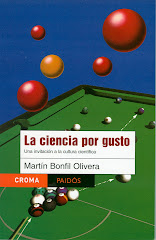by Martín Bonfil Olivera
Published on Milenio Diario, December 3, 2008
 Evaluating the quality of cultural projects is complex. Even more when we deal with the promotion, popularization, democratization of scientific culture. Two possible criteria are the acceptance of the public to which they are targeted, and their permanence.
Evaluating the quality of cultural projects is complex. Even more when we deal with the promotion, popularization, democratization of scientific culture. Two possible criteria are the acceptance of the public to which they are targeted, and their permanence.
With the above basis, I dare to declare that magazine ¿Cómo ves?, published by the Dirección General de Divulgación de la Ciencia (General Direction for Science Popularization) of UNAM (National Autonomous University of Mexico), which yesterday celebrated its first ten years with an event in Universum museum, is an example of top quality science promotion.
Apart from being the largest university publication in the Country (20 thousand copies monthly), ¿Cómo ves? has become one of our most successful popular science magazines. Not only because of its acceptance and permanence, but also because of the intrinsic quality of its contents , elaborated by a small but efficient multidisciplinary team that sums the knowledge of its collaborators — some experts in science; others, in science communication — with the rigorous work of correctors and editors, and the creativity of designers, illustrators and photographers, and an enthusiastic support group.
¿Cómo ves? not only divulges data: it offers scientific culture. Its first number stated that "our ambition is that you get to know where scientific knowledge comes from and how it is related with you and the society you live in". It has achieved its goal. More than scientific curiosity or isolated data, the magazine offers accessible and timely knowledge in context. Science, of course, but also its history, its conflicts and debates; its advances and retreats. It shows us science as a human activity that cannot be isolated from the rest of culture and society.
However, if the goal is to encourage science appreciation by the common citizen, the development in scientific and technical investigation, its vinculation with industry and productive sectors and finally, an improvement of the conditions of a society that, as ours, aspires to get out of the third world and become a first world country, the road is still long. Projects like ¿Cómo ves? are a very good start, but they are not enough. I hope these first ten years are useful as a stimulus for new scientific culture projects. We definitely need them.
(translated by Adrián Robles Benavides)
To receive Science for pleasure weekly
in your email, subscribe here!




No comments:
Post a Comment